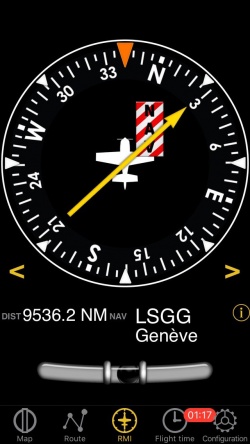(Created page with "---- <u>'''Nota:'''</u> recuerde que en los dispositivos iPhone y iPod Touche SÓLO encontrará el "spinball" en la parte inferior del instrumento. ---- ---- <br /> Volver a l...") |
(Updating to match new version of source page) |
||
| Line 2: | Line 2: | ||
<br /> | <br /> | ||
---- | ---- | ||
| − | [[File: | + | [[File:rmi_instr.jpg|caption|left|250px]]The RMI instrument in Air Navigation uses GPS information and does not receive any radio waves. |
<br /> | <br /> | ||
| − | + | The top part is the ADF indicator. The yellow needle is pointing towards the selected waypoint that corresponds to the longitudinal axis of the aircraft. | |
La rosa de los vientos puede ser rotada manualmente al presionar y arrastrar los dedos hacia arriba o abajo desde la izquierda o derecha del indicador. | La rosa de los vientos puede ser rotada manualmente al presionar y arrastrar los dedos hacia arriba o abajo desde la izquierda o derecha del indicador. | ||
| Line 10: | Line 10: | ||
Por debajo del indicador principal, el nombre del waypoint activo será exhibido, como también la distancia hasta el waypoint. Es posible seleccionar cualquier tipo de waypoint (Airports, VOR, NDB, etc) con el que trabajará el ADF, a diferencia de un ADF real que requiere waypoints que sean transmisores NDB o AM | Por debajo del indicador principal, el nombre del waypoint activo será exhibido, como también la distancia hasta el waypoint. Es posible seleccionar cualquier tipo de waypoint (Airports, VOR, NDB, etc) con el que trabajará el ADF, a diferencia de un ADF real que requiere waypoints que sean transmisores NDB o AM | ||
| − | + | Please read <u>[[Search Module]]</u> for more information about it. | |
| − | [[File: | + | [[File:warning_sign.png|caption|left]]A “NAV” warning flag will let you know that you should '''NOT''' trust the ADF indicator in the following cases: |
| − | * | + | * No waypoint is selected for the instrument; |
| − | * | + | * The waypoint distance is over 250 nautical miles; |
| − | * | + | * The GPS accuracy is less than 2.5 nautical miles. |
Revision as of 18:49, 3 November 2016
The RMI instrument in Air Navigation uses GPS information and does not receive any radio waves.
The top part is the ADF indicator. The yellow needle is pointing towards the selected waypoint that corresponds to the longitudinal axis of the aircraft.
La rosa de los vientos puede ser rotada manualmente al presionar y arrastrar los dedos hacia arriba o abajo desde la izquierda o derecha del indicador.
Por debajo del indicador principal, el nombre del waypoint activo será exhibido, como también la distancia hasta el waypoint. Es posible seleccionar cualquier tipo de waypoint (Airports, VOR, NDB, etc) con el que trabajará el ADF, a diferencia de un ADF real que requiere waypoints que sean transmisores NDB o AM
Please read Search Module for more information about it.
A “NAV” warning flag will let you know that you should NOT trust the ADF indicator in the following cases:- No waypoint is selected for the instrument;
- The waypoint distance is over 250 nautical miles;
- The GPS accuracy is less than 2.5 nautical miles.
Nota: recuerde que en los dispositivos iPhone y iPod Touche SÓLO encontrará el "spinball" en la parte inferior del instrumento.
Volver a la página anterior.
